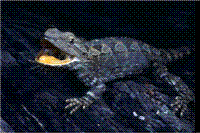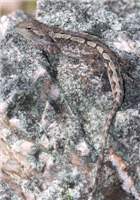Family
Agamidae (Dragons)
Genus
Amphibolurus
Species
Muricatus
Threats/Control Methods - Regional
Habitat destruction is the biggest threat to Jacky Lizards, this is mainly due to clearing of trees and shrubby vegetation on farms and for urban expansion.
Threats/Control Methods - Local
Cleaning up in nature reserves and gardens for legitimate reasons such as fire protection could pose a threat to populations within suburban Canberra.
Local/Urban Actions
In the suburbs, shrubby areas in nature reserves and gardens will provide the possibility for Jacky Lizards to recolonise urban Canberra.
Common name/s
Jacky Lizard, Tree Dragon
Distinguishing Features
Jacky Lizards tend to vary from light grey to brown, with pale whitish-grey markings down either side of the back. The tail is usually striped with the same pale colour. The inside of the mouth is bright yellow. Total length can be up to 40cm, although average is around 30cm, with 2/3 of this length made up by the tail.
Similar Species
In the ACT, the species that most closely resemble the Jacky Lizard are the Nobbi Dragon (Amphibolurus nobbi) and the Mountain Dragon (Tympanocryptus diemensis). The Nobbi Dragon has pink and blue insides of the mouth and a pale line down either side of its back. The Mountain Dragon has a blue mouth interior and orange tongue, and has much more pronounced spines than the Jacky Lizard.
Distribution
The Jacky Lizard's range extends from south-eastern Queensland, through NSW and Victoria to south-eastern South Australia. It is limited across the eastern part of its range to the slopes of the Great Diving Range. The lizard is common throughout the ACT, except in the cleared grazing areas and the Canberra urban area.
Country of Origin
Australia
Survey Techniques
Pitfall trapping and hand searching are used to locate these lizards during surveys.
Conservation (Pet/Pest) Status - National
Not listed as threatened under the EPBC Act 1999, although the species is listed as rare in South Australia.
Conservation (Pet/Pest) Status - Regional
Not listed as threatened.
LSCCES Population
Numbers of lizards are expected to decline with urban expansion.
Associated vegetation community
Woodlands, dry sclerophyll forests and heathlands.
Limiting Resources
Suitable habitat limits the species around the Canberra region, where many areas have been cleared of shrubs and trees which the lizard requires.
Breeding
Breeding occurs in spring, with eggs laid in late spring to early summer, with up to 12 eggs buried in a hole or under a log.
Behaviour
The Jacky Lizard is diurnal and arboreal. When threatened it will ably climb nearby trees to a safe height. Territorial with a few favourite basking places. Usually seen perched on fallen or standing timber.
Functional Group
Insectivorous
Food Species
The main diet of the Jacky Lizard is insects and other invertebrates. They occasionally will feed on small skinks, flowers, fruit or leaves.
Predators
Predators of the Jacky Lizard include raptors.
Interesting Fact
When Jacky Lizards fight over territory, displays include tail and arm waving and darkening of skin colour. Such displays may be used to warn off predators. The yellow inside the mouth is often shown in this instance.
References - (reader suitability of references, P=Primary teachers, S=Secondary students, T=Tertiary students and researchers)
Books:
Bennett, R. 1997. Reptiles & Frogs of the Australian Capital Territory, National Parks Association of the ACT, Woden. S, T
Swan, G., Shea, G. and Sadlier, R. 2004. A Field Guide to Reptiles of New South Wales, Second Edition, Reed New Holland, Sydney. S, T
Wilson, S. and Swan, G. 2003. A Complete Guide to Reptiles of Australia. Reed New Holland, Sydney. S, T
Journal Articles:
Carlile P, Peters R & Evans C, 2006. "Detection of a looming stimulus by the Jacky dragon (Amphibolurus muricatus): selective sensitivity to characteristics of an aerial predator". Animal Behaviour, 72, 553-562.
Online Publications:
Greer, A.E. 2006. Encyclopedia of Australian Reptiles. Australian Museum Online, Version date: 7 August 2006. T
http://www.amonline.net.au/herpetology/research/index.htm#encyclopedia
[Last accessed 01/05/07]
Researchers: Ian Rayner and Adam Houlden


 Top
Top Top
Top